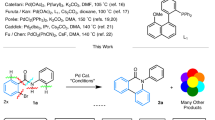Abstract
The generally accepted mechanism of the Suzuki—Miyaura reaction suggests a sequential activation of the substrate (aryl halide) and the reagent (arylboronic acid) by a palladium catalyst with the formation of unsymmetric biaryl as a result of a single turnover of the catalytic cycle, i.e., it is linear from the kinetic point of view. At the same time, the use of an unconventional kinetic approach based on the analysis of the differential selectivity of the reaction, rather than the regularities of catalytic activity, indicates the inadequacy of the linear mechanism, that is consistent with the hypothesis of a nonlinear (the so-called cooperative) mechanism of catalysis, in which the product is formed as a result of the substrate and reagent activation by two different palladium-containing intermediates in two parallel catalytic cycles. The experimentally observed low kinetic orders of the Suzuki—Miyaura reaction with respect to the concentration of the palladium catalyst precursor under the ligand-free conditions of catalysis are also consistent with the cooperative mechanism and can be due to the changes in the relative amount of the catalyst in two parallel catalytic cycles and/or to the process of catalyst deactivation.
Similar content being viewed by others
References
N. Miyaura, T. Yanagi, A. Suzuki, Synth. Commun., 1981, 11, 513; DOI: https://doi.org/10.1080/00397918108063618.
G. N. Lipunova, T. G. Fedorchenko, A. N. Tsmokalyuk, O. N. Chupakhin, Russ. Chem. Bull., 2020, 69, 1203; DOI:https://doi.org/10.1007/s11172-020-2892-6.
I. P. Beletskaya, F. Alonso, V. Tyurin, Coord. Chem. Rev., 2019, 385, 137; DOI: https://doi.org/10.1016/j.ccr.2019.01.012.
C. Torborg, M. Beller, Adv. Synth. Catal., 2009, 351, 3027; DOI: https://doi.org/10.1002/adsc.200900587.
L. P. E. Yunker, Z. Ahmadi, J. R. Logan, W. Wu, T. Li, A. Martindale, A. G. Oliver, J. S. McIndoe, Organometallics, 2018, 37, 4297; DOI: https://doi.org/10.1021/acs.organomet.8b00705.
A. A. Thomas, S. E. Denmark, Science, 2016, 352, 329; DOI:https://doi.org/10.1126/science.aad6981.
D. B. Eremin, V. P. Ananikov, Coord. Chem. Rev., 2017, 346, 2; DOI: https://doi.org/10.1016/j.ccr.2016.12.021.
A. Bourouina, V. Meille, C. de Bellefon, Catalysts, 2019, 9, 60; DOI: https://doi.org/10.3390/catal9010060.
A. Biffis, P. Centomo, A. Del Zotto, M. Zecca, Chem. Rev., 2018, 118, 2249; DOI: https://doi.org/10.1021/acs.chemrev.7b00443.
A. F. Schmidt, A. A. Kurokhtina, E. V. Larina, E. V. Vidyaeva, N. A. Lagoda, Mol. Catal., 2021, 499, 111321; DOI: https://doi.org/10.1016/j.mcat.2020.111321.
Y. Tan, F. Barrios-Landeros, J. F. Hartwig, J. Am. Chem. Soc., 2012, 134, 3683; DOI: https://doi.org/10.1021/ja2122156.
D. Wang, Y. Izawa, S. S. Stahl, J. Am. Chem. Soc., 2014, 136, 9914; DOI: https://doi.org/10.1021/ja505405u.
J. Kim, S. H. Hong, ACS Catal., 2017, 7, 3336; DOI: https://doi.org/10.1021/acscatal.7b00397.
S. Duric, F. D. Sypaseuth, S. Hoof, E. Svensson, C. C. Tzschucke, Chem. Eur. J., 2013, 19, 17456; DOI: https://doi.org/10.1002/chem.201302118.
G. C. Bond, R. H. Cunningham, J. Catal., 1997, 166, 172; DOI: https://doi.org/10.1006/jcat.1997.1490.
J. S. Mathew, M. Klussmann, H. Iwamura, F. Valera, A. Futran, E. A. C. Emanuelsson, D. G. Blackmond, J. Org. Chem., 2006, 71, 4711; DOI: https://doi.org/10.1021/jo052409i.
J. A. Widegren, R. G. Finke, J. Mol. Cat. A: Chem., 2003, 198, 317; DOI: https://doi.org/10.1016/S1381-1169(02)00728-8.
O. N. Temkin, Homogeneous Catalysis with Metal Complexes: Kinetic Aspects and Mechanisms, Wiley, Chichester, 2012, 803 pp.
A. F. Schmidt, A. A. Kurokhtina, E. V. Larina, Catal. Sci. Technol., 2014, 4, 3439; DOI: https://doi.org/10.1039/c4cy00479e.
A. F. Schmidt, A. A. Kurokhtina, E. V. Larina, Kinet. Catal., 2012, 53, 84; DOI: https://doi.org/10.1134/S0023158412010107.
C. Zhou, R. C. Larock, J. Org. Chem., 2006, 71, 3184; DOI: https://doi.org/10.1021/jo060104d.
A. F. Schmidt, A. A. Kurokhtina, E. V. Larina, Russ. J. Gen. Chem., 2011, 81, 1573; DOI: https://doi.org/10.1134/S1070363211070334.
Y. Chen, D.-M. Ma, F.-F. Ba, J. Sun, T. Liu, L. Zhu, M.-D. Zhou, Adv. Synth. Catal., 2016, 358, 2849; DOI: https://doi.org/10.1002/adsc.201600160.
A. F. Schmidt, A. A. Kurokhtina, E. V. Larina, E. V. Vidyaeva, N. A. Lagoda, J. Organomet. Chem., 2020, 929, 121571; DOI: https://doi.org/10.1016/j.jorganchem.2020.121571.
J. Xu, A. R. Wilson, A. R. Rathmell, J. Howe, M. Chi, B. J. Wiley, ACSNano, 2011, 5, 6119; DOI: https://doi.org/10.1021/nn201161m.
J. Ji, Y. Li, W. Fu, Z. Cui, J. Shen, M. Ye, J. Coll. Int. Sci., 2017, 505, 983; DOI: https://doi.org/10.1016/j.jcis.2017.06.013.
E. Song, J. Wang, T. Li, W. Zhao, M. Liu, Y. Wu, Mol. Catal., 2020, 482, 110671; DOI: https://doi.org/10.1016/j.mcat.2019.110671.
A. H. M. de Vries, J. M. C. A. Mulders, J. H. M. Mommers, H. J. W. Henderickx, J. G. de Vries, Org. Lett., 2003, 5, 3285; DOI: https://doi.org/10.1021/ol035184b.
M. T. Reetz and E. Westermann, Angew. Chem., Int. Ed., 2000, 39, 165; DOI: 0570-0833/00/3901-0167.
A. V. Gaikwad, A. Holuigue, M. B. Thathagar, J. E. ten Elshof, G. Rothenberg, Chem. Eur. J., 2007, 13, 6908; DOI: https://doi.org/10.1002/chem.200700105.
A. M. Trzeciak, A. W. Augustyniak, Coord. Chem. Rev., 2019, 384, 1; DOI:https://doi.org/10.1016/j.ccr.2019.01.008.
V. M. Chernyshev, E. A. Denisova, D. B. Eremin, V. P. Ananikov, Chem. Sci., 2020, 11, 6957; DOI:https://doi.org/10.1039/D0SC02629H.
S. B. Soliev, A. V. Astakhov, D. V. Pasyukov, V. M. Chernyshev, Russ. Chem. Bull., 2020, 69, 683; DOI: https://doi.org/10.1007/s11172-020-2818-3.
Author information
Authors and Affiliations
Corresponding author
Additional information
Published in Russian in Izvestiya Akademii Nauk. Seriya Khimicheskaya, No. 9, pp. 1657–1664, September, 2021.
This work was financially supported by the Russian Science Foundation (Project No. 19-13-00051). The research was carried out using facilities of the Center for Collective Use of Analytical Eequipment of the Irkutsk State University (http://ckp-rf.ru/ckp/3264/).
This paper does not contain descriptions of studies on animals or humans.
The authors declare no competing interests.
Rights and permissions
About this article
Cite this article
Lagoda, N.A., Kurokhtina, A.A., Larina, E.V. et al. The adequacy of the observed kinetic order in catalyst and the differential selectivity patterns to the hypothesis of the cooperative mechanism of catalysis of the Suzuki—Miyaura reaction. Russ Chem Bull 70, 1657–1664 (2021). https://doi.org/10.1007/s11172-021-3267-3
Received:
Revised:
Accepted:
Published:
Issue Date:
DOI: https://doi.org/10.1007/s11172-021-3267-3




